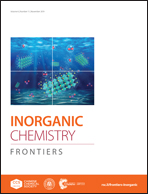Sky-blue thermally activated delayed fluorescence (TADF) based on Ag(i) complexes: strong solvation-induced emission enhancement†
Abstract
A new Ag(I) complex based on tris(2-pyridyl)phosphine (Py3P), [Ag2(Py3P)3(SCN)2], has been synthesized and chemically characterized. Theoretical calculations and photophysical investigations reveal thermally activated delayed fluorescence (TADF) coupled with outstanding solvato- and vapor-luminescent behavior. The parent complex [Ag2(Py3P)3(SCN)2] shows sky-blue TADF (λmax = 469 nm) at ambient temperature with a quantum yield of ΦPL = 16% and an emission decay time of 2.2 μs. Upon exposing the complex to CH2Cl2 or CHCl3 vapors, [Ag2(Py3P)3(SCN)2]·0.66CH2Cl2 and [Ag2(Py3P)3(SCN)2]·CHCl3 solvates are formed. This process is accompanied by a strong enhancement of the luminescence intensity. Both solvates also emit sky-blue TADF (λmax = 478–483 nm), but the emission quantum yield reaches ΦPL ≈ 70% at an emission decay time of 9–12 μs, depending on the solvent. According to DFT/TD-DFT computations, the observed TADF originates from a 1(M + X)LCT excited state. The experimentally determined ΔE(S1 − T1) gap for [Ag2(Py3P)3(SCN)2]·0.66CH2Cl2 is relatively large and amounts to 1040 cm−1 (≈129 meV).



 Please wait while we load your content...
Please wait while we load your content...